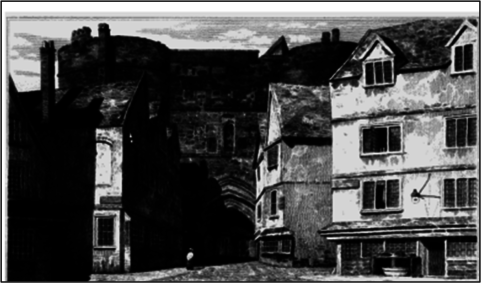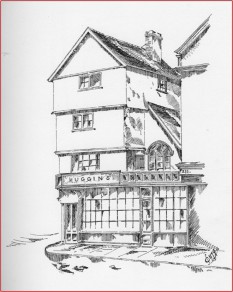
Workshop: Lost Buildings of Exeter, the 1800s
with Dr. Todd Gray on Thursday, 13 July 2023
at 10am at St Katherine's Priory
The workshop was held in order to talk about Dr Todd Gray’s latest book project, in partnership with Exeter Local History Society. The book which will be published later in the year will detail the Exeter buildings which were lost during the 1800s, many of them medieval.
Todd began by explaining that he is now a Trustee of St Katherine’s Priory which has its own rich history, and which had actually been saved from demolition at the hands of a builder (who had purchased the site for housing) by a huge protest headed by Miss Ethel Lega Weekes and Mr. A.W.Everett in the 1940s. The protest was successful, and the builder passed on the Priory to Exeter City Council who used it as a store and council house repair depot, before its being offered to the Stoke Hill Community Association.
Todd said that there were lots of reasons why buildings had been lost, and he had been following up on research for St Martin’s Island and other books he had published in the past. He had been using the Improvement Commission records and those at the Cathedral Archives and other archives in the UK and at the Bodleian Library in Oxford.
The focus of the new book is limited to those buildings lost within Exeter’s City Walls. His talk covered the loss of buildings, gates of the City and Cathedral, and modifications deemed necessary by the Improvement Commission to do with road widening, the setting back of parts of the frontage of buildings to create more space.
Todd showed images of the Guildhall, the corner of Goldsmith Street, and the building which had been in front of All Hallows Goldsmith Street Church, a medieval chemist’s shop run by the Huggins family which had been pulled down in 1879 for street widening, as far as Paul Street. The Church itself was later pulled down in 1904-5. In the late 1800s two artists by the name of George Townsend and John Gendall sketched buildings as they were being demolished to create an accurate record of what they had looked like. Many images that are in existence are not so accurate as they were retrospective and drawn from what individuals could remember of how they looked like, an example being the West Gate. However, Todd had managed to find a rare, never before published image in the British Library by John Carter which had been drawn in 1770 before the Gate was demolished in 1815. Todd talked about the Reformations of the 1530s and 1540s, the 1650s and the 1800s. He said that every generation had their own preferences of building styles and that the Victorians were no exception. The 1530s and 1540s saw the dissolution of the abbeys and priories, and the 1650s saw the buildings surrounding the Cathedral, which were converted to other uses, examples being the Deanery which was turned into the Bishop’s Palace, and the Cloisters which were demolished. This resulted in a situation where the builder who was contracted to do the job, also had a contract to improve the road from Paris Street to Heavitree. He therefore used the bones and skeletons which had been dug up to help fill in holes in the road! The 1800s saw Exeter’s seven Cathedral gates removed (which had been built when the Precentor had been murdered in the 1280s). Broadgate was the ceremonial gate (known as St. Michael’s Gate) and was removed in 1824-1825. Pitman Jones attempted to save it as a relic to re-erect it in Northernhay Gardens but was not successful. Some buildings were demolished and rebuilt, only to be demolished again in later years, examples being the Cloisters which became the Cloth Market, and St Mary Major Church, its final rebuilding deemed to be too close to the Cathedral and demolished again in the 1970s. Todd showed images of the Vicars Choral in South Street, and St. George’s Church.
The biggest travesty concerning the loss of buildings was that by the Cathedral authorities which removed countless medieval buildings deemed to be too close in proximity and thus spoiling the view of the Cathedral. The work of the Improvement Commission dealt with generally cleaning up the City but had no rights or jurisdiction for the Cathedral Precinct. Improvements involved cutting back the frontage of buildings for road widening and selling off the building materials. Improvements for the city were mainly geared towards the middle class, not the likes of the poor of the West Quarter. The Improvement Commission also focused on lighting, water, City gates and streets generally. Before West Gate was removed in 1815 access to the town was via Stepcote Hill and West Street but once the Exe Bridge was built it was possible to travel up Fore Street to the town. South Gate along with its prison was demolished in 1819 and Quay Gate in 1815. St John’s Church in Fore Street was demolished leaving only the clock tower and its monuments were moved from church to church.
Todd showed images of South Street with workmen on ladders pulling down 30ft of the buildings to set them back. Images were shown of Butchers’ Row in Smythen Street, and the Lower Market (now the Corn Exchange) and the Higher Market in Queen Street. Queen Street itself was created in the 1830s. In North Street every building was in part taken down and the frontage of 20 North Street was re-erected at 229 High Street [later Lyon’s Cafe].
We were nearing the end of our booked time at St Katherine’s Priory and Todd ended with images of the Chevalier at the top of Fore Street, the Rose & Crown drawn by John Gendall which was originally at the top end of High Street near Boots, the medieval mosaic pavement in the old Police Station in Waterbeer Street, a St Kerrian’s Church monument which had been moved from North Street to St Petrock’s Church, the Puzzle Jug found in South Street near the White Hart and now in the RAMM, the ornate window which had been part of Elyot’s House (between Broadgate and Cathedral Yard, with its rear on High Street near South Street) and removed to the Bishop’s Palace, the St Peter statue at the corner of North Street, the Swan Tavern in Queen Street and the King John’s Tavern in South Street.
All in all a fascinating introduction to what promises to be an extremely interesting book and which Exeter Local History Society is proud to be associated with.
[Sue Jackson]


